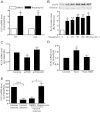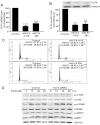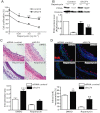Krüppel-like factor 4 is induced by rapamycin and mediates the anti-proliferative effect of rapamycin in rat carotid arteries after balloon injury
- PMID: 22017667
- PMCID: PMC3413870
- DOI: 10.1111/j.1476-5381.2011.01734.x
Krüppel-like factor 4 is induced by rapamycin and mediates the anti-proliferative effect of rapamycin in rat carotid arteries after balloon injury
Abstract
Background and purpose: The transcription factor, Krüppel-like factor 4 (KLF4), plays an important role in regulating the proliferation of vascular smooth muscle cells. This study aimed to examine the effect of rapamycin on the expression of KLF4 and the role of KLF4 in arterial neointimal formation.
Experimental approach: Expression of KLF4 was monitored using real-time PCR and immunoblotting in cultured vascular smooth muscle cells. and in rat carotid arteries in vivo after balloon injury. Adenovirus-mediated overexpression and siRNA-mediated knockdown of KLF4 were used to examine the role of KLF4 in mediating the anti-proliferative role of rapamycin . KLF4-regulated genes were identified using cDNA microarray.
Key results: Rapamycin induced the expression of KLF4 in vitro and in vivo. Overexpression of KLF4 inhibited cell proliferation and the activity of mammalian target of rapamycin (mTOR) and its downstream pathways, including 4EBP-1 and p70S6K in vascular smooth muscle cells and prevented the neointimal formation in the balloon-injured arteries. KLF4 up-regulated the expression of GADD45β, p57(kip2) and p27(kip1) . Furthermore, knockdown of KLF4 attenuated the anti-proliferative effect of rapamycin both in vitro and in vivo.
Conclusions and implications: KLF4 plays an important role in mediating the anti-proliferative effect of rapamycin in VSMCs and balloon-injured arteries. Thus, it is a potential target for the treatment of proliferative vascular disorders such as restenosis after angioplasty.
© 2011 The Authors. British Journal of Pharmacology © 2011 The British Pharmacological Society.
Figures






Similar articles
-
Downregulation of quinone reductase 2 attenuates vascular smooth muscle cells proliferation and neointimal formation in balloon injured rat carotid artery.Cell Physiol Biochem. 2012;29(3-4):453-62. doi: 10.1159/000338499. Epub 2012 Apr 3. Cell Physiol Biochem. 2012. PMID: 22508052
-
Pathological Role of Phosphoglycerate Kinase 1 in Balloon Angioplasty-Induced Neointima Formation.Int J Mol Sci. 2021 Aug 17;22(16):8822. doi: 10.3390/ijms22168822. Int J Mol Sci. 2021. PMID: 34445528 Free PMC article.
-
Identification of PI3K regulatory subunit p55γ as a novel inhibitor of vascular smooth muscle cell proliferation and neointimal formation.Cardiovasc Res. 2015 Jan 1;105(1):75-85. doi: 10.1093/cvr/cvu235. Epub 2014 Nov 10. Cardiovasc Res. 2015. PMID: 25388664
-
Effects of flavonoids on MicroRNA 145 regulation through Klf4 and myocardin in neointimal formation in vitro and in vivo.J Nutr Biochem. 2018 Feb;52:27-35. doi: 10.1016/j.jnutbio.2017.08.016. Epub 2017 Sep 14. J Nutr Biochem. 2018. PMID: 29127880
-
Role of Kruppel-like factor 4 in atherosclerosis.Clin Chim Acta. 2021 Jan;512:135-141. doi: 10.1016/j.cca.2020.11.002. Epub 2020 Nov 9. Clin Chim Acta. 2021. PMID: 33181148 Review.
Cited by
-
Endothelial mechanobiology.APL Bioeng. 2020 Feb 20;4(1):010904. doi: 10.1063/1.5129563. eCollection 2020 Mar. APL Bioeng. 2020. PMID: 32095737 Free PMC article.
-
Elevated circulating Krüppel-like factor 4 level as a novel independent marker of the proatherogenic risk in patients with psoriasis: a preliminary study.Postepy Dermatol Alergol. 2021 Dec;38(6):1023-1031. doi: 10.5114/ada.2020.98560. Epub 2020 Sep 2. Postepy Dermatol Alergol. 2021. PMID: 35126010 Free PMC article.
-
S-nitrosation impairs KLF4 activity and instigates endothelial dysfunction in pulmonary arterial hypertension.Redox Biol. 2019 Feb;21:101099. doi: 10.1016/j.redox.2019.101099. Epub 2019 Jan 7. Redox Biol. 2019. PMID: 30660098 Free PMC article.
-
Adenosine kinase is critical for neointima formation after vascular injury by inducing aberrant DNA hypermethylation.Cardiovasc Res. 2021 Jan 21;117(2):561-575. doi: 10.1093/cvr/cvaa040. Cardiovasc Res. 2021. PMID: 32065618 Free PMC article.
-
Circadian rhythm influences induction of trained immunity by BCG vaccination.J Clin Invest. 2020 Oct 1;130(10):5603-5617. doi: 10.1172/JCI133934. J Clin Invest. 2020. PMID: 32692732 Free PMC article.
References
-
- Adam PJ, Regan CP, Hautmann MB, Owens GK. Positive- and negative-acting Kruppel-like transcription factors bind a transforming growth factor beta control element required for expression of the smooth muscle cell differentiation marker SM22alpha in vivo. J Biol Chem. 2000;275:37798–37806. - PubMed
-
- Agrotis A, Kanellakis P, Kostolias G, Di Vitto G, Wei C, Hannan R, et al. Proliferation of neointimal smooth muscle cells after arterial injury. Dependence on interactions between fibroblast growth factor receptor-2 and fibroblast growth factor-9. J Biol Chem. 2004;279:42221–42229. - PubMed
-
- Bayes-Genis A, Campbell JH, Carlson PJ, Holmes DR, Jr, Schwartz RS. Macrophages, myofibroblasts and neointimal hyperplasia after coronary artery injury and repair. Atherosclerosis. 2002;163:89–98. - PubMed
-
- Clowes AW, Reidy MA, Clowes MM. Mechanisms of stenosis after arterial injury. Lab Invest. 1983;49:208–215. - PubMed
Publication types
MeSH terms
Substances
Grants and funding
LinkOut - more resources
Full Text Sources
Molecular Biology Databases
Miscellaneous

